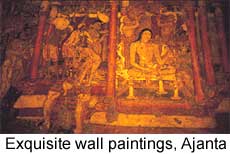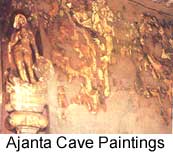

 |  |
|
|
|

They are situated near Aurangabad in Maharashtra. They are both chaityas and viharas. They are cut out of a large rocky plateau. These historical structures are related to Jainism, Buddhism and Hinduism. The caves at Ajanta have 24 Buddhist viharas and five Hindu temples. These are carved out of a rock of about 80 metres high and about 380 metres long. The caves of Ajanta are related to both Hinayana and Mahayana sect of Buddhism. Some of the finest sculptures and paintings are in the caves at Ajanta. Paintings are found in only a few of these caves, which were created between 100 B.C. and the A.D. 400's. 
Viharas of Ajanta are of different sizes. There is a pillared verandah in front, from which doors and windows lead into the main hall. The side walls of the hall have doors for the monks to enter their cells. In the centre of the rear wall is a doorway leading into a shrine having the rock cut image of Buddha which is calm, solemn and inspring. There are many chaityas at Ajanta, of which the chaitya number 19 is most remarkable. The fašade of the chaitya is decorated with sculptured images. Inside there are two Buddha figures standing in a relaxed pose. At the far end, there is an imposing stupa having the standing image of Buddha. The fresco paintings on the walls and ceilings of Ajanta are known for their artistic values. The themes of the paintings are drawn from the Jataka tales, legends and real life. These paintings reflect all phases of Indian culture from the birth of Buddha to the 8th century A.D. Inspite of the inclement weather and the passage of time, colours of these paintings are very fresh. Craftworkers who were organized in groups similar to guilds carried out the work at the caves. Some cut out the rock and sculpted it. Others applied a layer of plaster over the rock surface, made drawings, and then painted the murals using natural pigments such as ochre. The Ajanta paintings have rich and varied shades of yellows, browns, reds, and greens. Blue was used, more sparingly, in later works. The blue pigment was made from a costly imported mineral, lapis lazuli. One of the most beautiful paintings shows a Bodhisattva, a person striving to become a Buddha. He holds a blue lotus, and his skin is slightly tinged with blue so that he seems to glow in the dim light of the cave. His body is shaded to give a sense of its form and contours. The artist has depicted his body with a slight bend so that he appears to look down on the sorrow of the world with gentle kindness. Many painters show realistic scenes from Buddhist stories. Ordinary people are shown at everyday tasks, and even beggars are included in the paintings. Scenes set in palaces give us an idea of what long-vanished palace buildings were like. The artists have drawn them to look three-dimensional. The skill of the artists is also apparent in the convincing way that the figures seem to move freely. Most important of all is the artists' rich human insight; their ability to show devotion on the face of a worshipper and adoration on the face of a lover. The sculptors of Ajanta were just as talented as the painters, creating wonderfully modelled figures, full of energy and elegance. They did not treat bodies as frames of bone on which to hang flesh. Instead, as in yoga, they saw the ideal body as full of breath, the inner life force, apparently pushing outward from within. Faces and limbs are soft and rounded and portrayed with naturalistic (realistic) detail. |
Copyright ©2000 indiansaga.info. All rights reserved.
By using this service, you accept that you won't copy or use the data given in this website for any commercial purpose.
The material on indiansaga.info is for informational & educational purpose only.
This site is best viewed at 800 X 600 picture resolution.